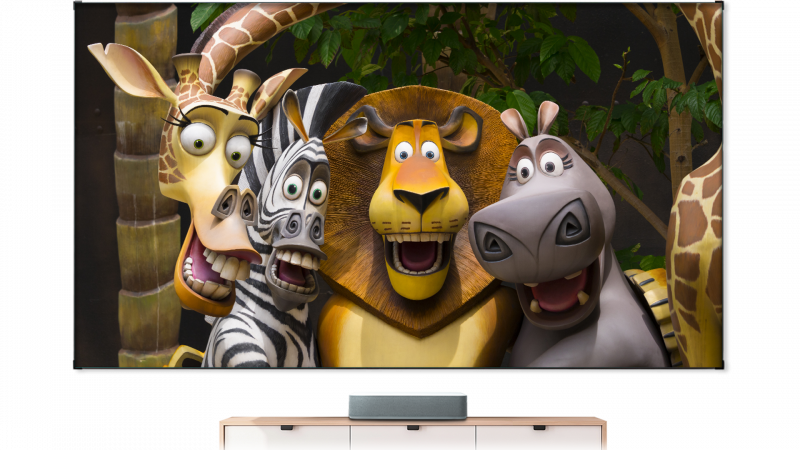
What is ALR Projector Screen? How do Ambient Light Rejection screens work?
The ‘ALR’ refers to ‘Ambient Light Rejection. These screens can be used in areas where there is a lot of ambient light that comes through open curtains, windows, or doors. Light is selectively reflected in the audience by an ALR screen. These screens are only effective if the ambient light does not come from the same direction as the projector.
ALR PROJECTOR SCREEN
An ALR screen is a light-reflecting screen that rejects ambient light and reflects it to the audience. The projector and screen should be positioned so that the projector light is reflected in the audience. The room’s other ambient light reflects in a different direction. The ALR projector screens are very effective when ambient light is coming from multiple directions on the screen and projector. Even without turning off the lights, you can use it to project video games or other content.

The ALR screen is better suited to regular projectors. You must turn off the lights as you would with a standard projector, but you do not need to do so with an ALR screen. You can see everything at any time.
How does the ALR screen work?
The ALR screen reflects light to the audience, brightening the projected image. The ambient light is redirected away from the viewers. It produces high-quality visuals even when the room lights are turned on by raising the brightness and minimizing the ambient light.
If the ambient light is less than a specified threshold of brightness in lumens, the projector light will be weakened. As the ambient light weakens, the projector light grows stronger and more visible to your eyes. ALR, like any excellent lighting system, reflects and redirects light to the audience at the appropriate angle. Consider the light from a strong flashlight as an example of ambient light. During the day, flashlights are not brighter, but at night, they are.
Is it worth buying the ALR screen?
In some situations and locations, ALR screens are worth investing in. These screens can be a viable solution in schools and conference rooms when ambient light sources are needed. In such situations, an ALR screen can help by allowing more ambient light in. Even in low-light situations, their screens give improved image quality. To improve the viewing quality of the projected image on the screen, you don’t need to dim the lights.
What factors are vital when buying an ALR screen?
Rejected Percentage of Ambient Light
To be considered a legitimate ALR screen, this must be at least 81 percent.
Gain
Reflection measurement of the screen area. Screen with a gain of 1.5 reflects 51% additional light than whiteboard, whereas a screen with a gain of 0.8 reflects 81% of light from the whiteboard.
Gain has an impact on the viewing angle. A higher gain screen will usually appear brightest to individuals sitting closest to the screen’s center point.
Viewing Angle
Double the half-angle; for example, if the half-angle of a screen is 80 degrees, the viewing angle will be 160 degrees.
Throw Distance
Difference between the tip of the screen and the projector lens. Throw projection ratios of 1.0:1 or above are considered standard. A projection ratio of 0.4:1 or less is considered an ultra-short throw.
What is the brightness of an ALR screen?
The type of projector utilized and its gain determines the brightness of an ALR screen.
Why Choose an ALR Projector Screen
Screens with ALR technology are made in such a way that they absorb or reject any ambient light in the room. What difference does it make? Consider the various locations where a projection screen could be used: living rooms, outdoors, corporate conference halls, media rooms, and so on. Unless the environment is dark, controlling the other competing light sources can be quite difficult. ALR displays can very handy in this situation. Regardless of other light sources, they’ll give you the best image possible.
Ambient Light Rejecting Projector screens are not all same. They range in terms of size, type, and quality, as well as how well they work with the projector you can use with them. To begin, ALR Screens are divided into two categories: angular/specular reflective and retro-reflective. Each has a unique way of reflecting ambient light sources and is suitable for a variety of scenarios.

Taylor is a freelance SEO copywriter and blogger. His areas of expertise include technology, pop culture, and marketing.





![How to Watch UFC 303 Live Stream Free [Updated 2024] UFC 259 Live Stream Free](https://techsmartest.com/wp-content/uploads/2022/03/UFC-259-Live-Stream-Free-100x70.jpg)
![How to Access UFC 302 Live Stream Free [Updated 2024] UFC 260 Live Stream Free](https://techsmartest.com/wp-content/uploads/2022/03/UFC-260-Live-Stream-Free-100x70.jpg)








